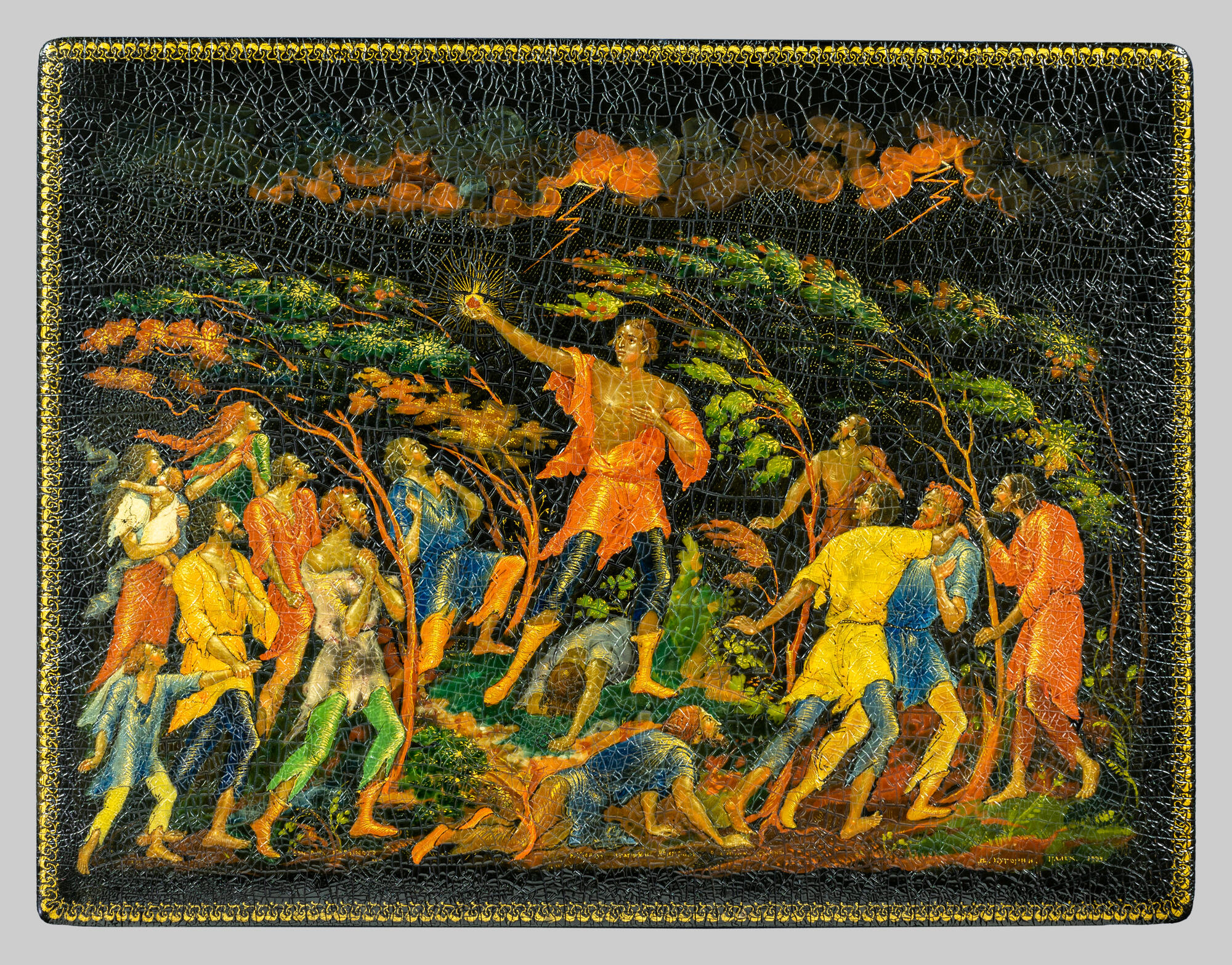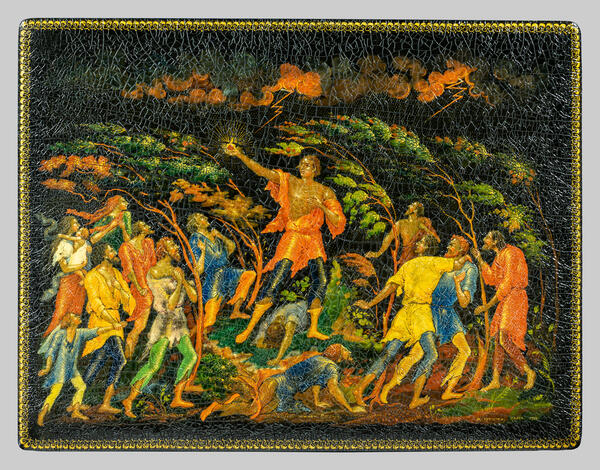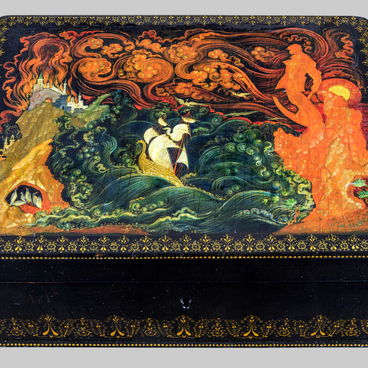Dmitry Butorin painted the miniature ‘Danko’ in 1934. It is based on the legend of a young man named Danko from Maxim Gorky’s story “Old Izergil.” The legend says that Danko tore a flaming heart out of his chest to light the way for his kinsmen, who were wandering in an impenetrable forest, dying in swamps and gradually losing faith in salvation. But the power of DAnko’s love for people was so great that its light defeated the doubts of the crowd.
The artist turned to this legend in his works more than once. This composition is considered one of the best thanks to the skillful choice of symbolic accents. Butorin eliminated all unnecessary details. Danko looks less expressive here, and the silhouettes of the people and the elements of the landscape are more generalized. The use of a more subtle color palette with rhythmically repeating red spots also makes the work look whole. Yellow is the dominating color here. The artist applied it in full force, without any nuances.
All the other colors feature the slightest variations of shades. Butorin achieved this effect with the help of a light, slightly translucent roskrysh—in the Palekh art, this word is used to describe the first uniform coat of paint applied to the entire picture inside the contours. The roskrysh is then covered by a very thin, translucent layer of paint. At the final stage, the artist applies strokes of light paint, called gaps, that give volume to the figures. The Palekh artists often use gaps filled with gold paint, applying them in the finest, bristle-like lines.
The Palekh art features many examples of paintings inspired by the works of Maxim Gorky. The writer’s early stories has a songlike rhythm—a concept close to the Palekh art. The image of the brave Danko created by Dmitry Butorin is one of the most vivid and memorable painted versions of this hero.
The way Danko is portrayed in the miniature is reminiscent of the well-known Old Russian icons. A similar image can be found in the Last Judgment fresco in the Assumption Cathedral in Vladimir. Its authors, Andrey Rublev and Daniil Chernyi, depicted the Holy Apostle Peter leading the righteous to Heaven. The image of Danko is also reminiscent of the angel in the icon by a Palekh artist called “Joy of All Who Sorrow”: in it, a messenger of the Virgin Mary is leading the lost people out of the forest. In his miniature “Danko”, the former icon painter Dmitry Butorin also created the image of universal salvation: here, the hero shows the others a path to a new world similar to Heaven.
According to researchers, at the beginning of his career, Dmitry Butorin was influenced by the works of Ivan Golikov. Both authors share a similar light, accurate, and dynamic style of painting. The artist’s style is also close to that of Aleksand Kotukhin in terms of color brightness and the golden gap technique. They both also liked compact forms and filigree patterns.
The artist turned to this legend in his works more than once. This composition is considered one of the best thanks to the skillful choice of symbolic accents. Butorin eliminated all unnecessary details. Danko looks less expressive here, and the silhouettes of the people and the elements of the landscape are more generalized. The use of a more subtle color palette with rhythmically repeating red spots also makes the work look whole. Yellow is the dominating color here. The artist applied it in full force, without any nuances.
All the other colors feature the slightest variations of shades. Butorin achieved this effect with the help of a light, slightly translucent roskrysh—in the Palekh art, this word is used to describe the first uniform coat of paint applied to the entire picture inside the contours. The roskrysh is then covered by a very thin, translucent layer of paint. At the final stage, the artist applies strokes of light paint, called gaps, that give volume to the figures. The Palekh artists often use gaps filled with gold paint, applying them in the finest, bristle-like lines.
The Palekh art features many examples of paintings inspired by the works of Maxim Gorky. The writer’s early stories has a songlike rhythm—a concept close to the Palekh art. The image of the brave Danko created by Dmitry Butorin is one of the most vivid and memorable painted versions of this hero.
The way Danko is portrayed in the miniature is reminiscent of the well-known Old Russian icons. A similar image can be found in the Last Judgment fresco in the Assumption Cathedral in Vladimir. Its authors, Andrey Rublev and Daniil Chernyi, depicted the Holy Apostle Peter leading the righteous to Heaven. The image of Danko is also reminiscent of the angel in the icon by a Palekh artist called “Joy of All Who Sorrow”: in it, a messenger of the Virgin Mary is leading the lost people out of the forest. In his miniature “Danko”, the former icon painter Dmitry Butorin also created the image of universal salvation: here, the hero shows the others a path to a new world similar to Heaven.
According to researchers, at the beginning of his career, Dmitry Butorin was influenced by the works of Ivan Golikov. Both authors share a similar light, accurate, and dynamic style of painting. The artist’s style is also close to that of Aleksand Kotukhin in terms of color brightness and the golden gap technique. They both also liked compact forms and filigree patterns.



